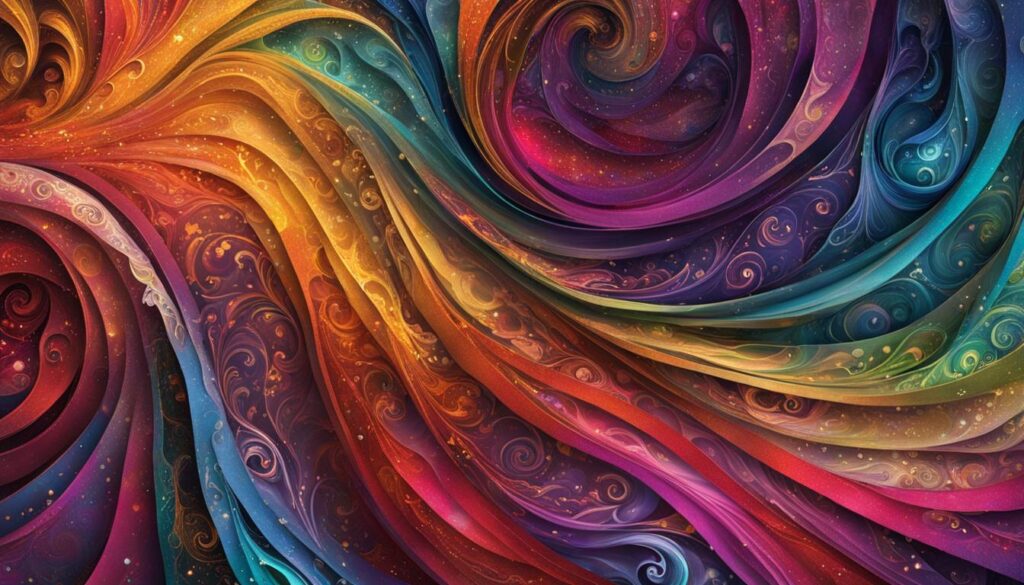We may earn money or products from the companies mentioned in this post.
Journaling is not only a great way to express your thoughts and emotions, but it also provides an opportunity to tap into your creativity. Whether you’re new to journaling or a seasoned writer, there are many ways to enhance your journaling practice and explore your artistic side.
In this section, we will delve into some creative journaling ideas, including journal prompts, art journaling, and more. These ideas will enable you to unlock your imagination and explore your innermost thoughts and feelings.
Key Takeaways:
- Creative journaling provides an opportunity for self-expression and personal growth.
- Journal prompts are an excellent way to delve deeper into your thoughts and emotions.
- Art journaling techniques allow you to combine writing, drawing, and painting to create visually stunning pages.
- Exploring different journaling styles, such as gratitude journaling or dream journaling, can bring inspiration and joy to your practice.
- Incorporating visual elements into your journal, such as photographs and ephemera, can enhance your creativity.
Journal Prompts for Self-Reflection and Self-Discovery
Journaling can be a powerful tool for personal growth, allowing you to reflect on your past experiences, process emotions, and gain new insights into yourself. Here are some journal prompts to help you delve deeper into your inner world and explore your thoughts and feelings:
- What are three things I am grateful for today?
- What are some things I can do to take care of myself today?
- What is one thing I can forgive myself for?
- What is one thing I am proud of myself for?
- What is one thing I can do to challenge myself and grow?
- What are some fears that are holding me back, and how can I overcome them?
These prompts can help you gain a better understanding of yourself and your needs, leading to personal growth and self-discovery.
Journaling Techniques for Self-Reflection
In addition to journal prompts, there are also various journaling techniques that can aid in self-reflection. One such technique is stream-of-consciousness journaling, where you write down whatever comes to mind without censoring or judging your thoughts. This can help you access deeper layers of your consciousness and gain new insights into your emotions and beliefs.
Another technique is visualization journaling, where you close your eyes and imagine a specific scenario or experience that you want to explore. Then, you write about what you see, feel, and hear in your mind’s eye. This can help you tap into your creativity and access your subconscious mind.
Journaling Techniques for Self-Discovery
Journaling can also aid in self-discovery by helping you explore your values, beliefs, and desires. One useful technique is goal-setting journaling, where you write down your short-term and long-term goals and create actionable steps to achieve them. This can help you clarify your priorities and create a sense of direction in your life.
Another technique is inner-child journaling, where you write from the perspective of your younger self and explore the experiences and emotions that shaped you. This can help you gain a deeper understanding of your past and heal old wounds.
By using these journaling techniques and prompts, you can gain a greater understanding of yourself and foster personal growth and self-discovery.
Art Journaling Techniques to Enhance Creative Expression
Art journaling is a unique form of self-expression that combines visual art and journaling. It offers an opportunity to express yourself creatively, explore your emotions, and reflect on your experiences. Here are some art journaling techniques that can help enhance your creative expression:
1. Collage
Collage is the technique of combining different images and textures to create a visual composition. In art journaling, collage can be used to express emotions, represent dreams or aspirations, and create visually interesting pages. To create a collage, start by gathering images from magazines, newspapers, or your own photos. Cut or tear out the images and arrange them on your page. Use glue to secure them in place.
2. Drawing and Doodling
Drawing and doodling are great ways to add visual interest and personality to your journal pages. You don’t have to be an artist to use this technique – just start drawing and see where it takes you. Experiment with different mediums like pen, pencil, markers, or watercolors. Don’t worry about making mistakes – art journaling is all about self-expression.
3. Painting
Painting is a versatile technique that can add depth and texture to your journal pages. You can use acrylics, watercolors, or any other type of paint you prefer. You can paint over collaged images or use it as a background. Mix different colors and experiment with techniques like splattering or sponging to create unique effects.
4. Stenciling
Stenciling is a technique that involves using pre-made templates to create shapes and patterns. You can use stencils to add interest to your pages, create a cohesive design, or add emphasis to certain elements. You can make your own stencils using paper or buy them online or at a craft store.
5. Mixed Media
Mixed media is a technique that combines different art forms, like painting, drawing, collage, and printmaking, to create a unique composition. In art journaling, mixed media can be used to express complex emotions, tell a story, or create a mood. Experiment with different media and see how you can combine them to create something new.
By using art journaling techniques, you can enhance your creative expression and create visually stunning journal pages. Don’t be afraid to experiment and try new things – art journaling is all about self-discovery and personal growth. Remember, your journal is a reflection of your unique personality, so have fun and let your creativity shine!
Mindfulness Journaling for Inner Peace and Clarity
Modern life can be overwhelming, and it’s easy to get caught up in the stress and distractions of our daily routines. Mindfulness journaling is a powerful tool that can help you find inner peace and clarity amidst the chaos. By bringing awareness to the present moment and cultivating a sense of stillness, you can reduce stress, increase self-awareness, and improve overall well-being.
What is Mindfulness Journaling?
Mindfulness journaling involves writing in a journal with a focused and nonjudgmental awareness of your thoughts and feelings. It’s a form of self-reflection that encourages you to observe your thoughts without getting caught up in them. By remaining present and aware, you can gain a deeper understanding of your inner world and develop a stronger sense of self.
Journaling Techniques for Mindfulness
There are many different techniques you can use for mindfulness journaling. Here are a few ideas to get you started:
- Morning Pages: Write three pages of stream-of-consciousness writing first thing in the morning. Don’t worry about grammar or punctuation; just write whatever comes to mind.
- Gratitude Journaling: Take a few minutes each day to write down three things you’re grateful for. This can help shift your focus from negativity to positivity.
- Body Scan: Take a few minutes to sit quietly and scan your body from head to toe, noticing any sensations or areas of tension. Write about what you observe.
Benefits of Mindfulness Journaling
Mindfulness journaling offers numerous benefits for your mental and emotional well-being. It can:
- Reduce stress and anxiety
- Increase self-awareness
- Improve focus and concentration
- Cultivate a sense of gratitude and positivity
Explore Different Journaling Styles for Inspiration
Journaling offers a unique and personal way to express oneself, and the style of journaling you choose can greatly impact your creative expression and personal growth. Here are some inspiring journaling styles to explore:
Gratitude Journaling
Gratitude journaling involves writing down what you are grateful for each day. It’s a simple but powerful practice that can shift your focus from what you lack to what you have. By cultivating an attitude of gratitude, you can increase your overall well-being and find joy in the present moment.
Dream Journaling
Keeping a dream journal can help you remember and analyze your dreams. Dreams can reveal your deepest desires, fears, and thoughts, providing insight into your subconscious mind. By exploring your dreams, you can gain a better understanding of yourself and your inner world.
Bullet Journaling
Bullet journaling is a versatile journaling style that combines writing with visual elements like symbols, charts, and calendars. It’s a customizable system that can help you stay organized, track your goals, and reflect on your progress. Bullet journaling can also be a form of creative expression, allowing you to unleash your artistic side.
Stream of Consciousness Journaling
Stream of consciousness journaling involves writing down your thoughts as they come, without censoring or editing them. It’s a free-flowing practice that can help you access your subconscious and tap into your creativity. By letting your thoughts spill onto the page, you can gain clarity and insight into your inner world.
Collage Journaling
Collage journaling involves creating visual compositions by combining images, words, and other materials. It’s a fun and intuitive process that can spark your creativity and allow you to express yourself in a unique way. Collage journaling can also be a way to explore themes and ideas that resonate with you.
Whatever journaling style you choose, remember that it’s a personal practice that can bring you joy, healing, and personal growth. Explore different styles and find what works best for you. Happy journaling!
Incorporate Visual Elements into Your Journal
If you are looking to take your art journaling to the next level, consider incorporating visual elements into your pages. Drawing, doodling, painting, and collaging can give your journal an eye-catching appeal and help you express yourself in new ways. Here are a few techniques to try:
| Technique | Description |
|---|---|
| Drawing | Use fine-tip pens or pencils to add sketches or intricate designs to your pages. Sketching is a great way to add texture, shade, and detail to your journal entries. |
| Doodling | Let your mind wander and fill your pages with whimsical, free-form designs. Doodling can help you relax and unleash your creativity. |
| Painting | Use acrylic or watercolor paints to add vibrant colors and bold strokes to your pages. Painting can be a great way to express your emotions and create dynamic visuals. |
| Collage | Use magazine cutouts, photos, or other found materials to create mixed media art on your pages. Collage can add layers of meaning and symbolism to your journal entries. |
Remember, there are no rules when it comes to incorporating visual elements into your journal. Play around with different techniques and materials to create a unique and personalized journaling experience. Let your creativity run wild and see where it takes you!
Pro tip: If you’re unsure where to start, try browsing art journals on social media for inspiration. You may be surprised at what you find!
Use Creative Writing Prompts to Spark Imagination
Creative writing prompts are a fantastic tool for anyone looking to enhance their journaling experience. They are designed to challenge your creativity, expand your thinking, and help you gain insight into yourself. If you’re stuck in a journaling rut or looking for a way to boost your personal growth, try incorporating some of these creative writing prompts into your journal:
- If you could travel back in time and relive any moment in your life, what would it be and why?
- Write about a time when you felt completely out of your comfort zone. What did you learn from the experience?
- What are the top five things that bring you joy? Write about why these things make you happy.
- If you could have any superpower, what would it be and why?
- Write about something you fear and how it influences your life.
By using these creative writing prompts, you can push the boundaries of your imagination and tap into your innermost thoughts and desires. You may discover new insights about yourself or find a fresh perspective on a particular issue. Writing creatively is an excellent way to foster personal growth and develop your creative expression. So, next time you sit down to write in your journal, try using a creative writing prompt to spark your imagination.
Conclusion
In conclusion, creative journaling is an excellent tool for self-expression, personal growth, and finding inner peace. Through journal prompts, art journaling techniques, mindfulness-based exercises, and different styles of journaling, you can tap into your creative potential and discover a deeper connection with yourself.
By incorporating visual elements and creative writing prompts, you can add a new dimension to your journaling practice and spark your imagination. Remember, the key to successful journaling is to be consistent and authentic in your self-expression.
Start your creative journaling journey today and see where it takes you. Whether you’re an experienced journaler or just starting, there’s no wrong way to express yourself. So grab your journal and unleash your creativity!
FAQ
What is creative journaling?
Creative journaling is a practice of using various techniques and prompts to express your thoughts, emotions, and ideas through writing, drawing, painting, and other artistic mediums. It allows you to tap into your creativity and explore your inner world.
How can creative journaling enhance personal growth?
Creative journaling provides an opportunity for self-reflection, self-discovery, and self-expression. By engaging in this practice, you can gain insights into yourself, identify patterns, set goals, explore new perspectives, and foster personal growth and development.
What are journal prompts?
Journal prompts are thought-provoking questions or statements that serve as a starting point for your journaling practice. They can help spark inspiration, encourage self-reflection, and guide your writing process. Journal prompts can cover a wide range of topics and themes.
What is art journaling?
Art journaling is a form of creative expression that combines writing, drawing, painting, and collage techniques in a journal or sketchbook. It allows you to create visually stunning and meaningful pages that reflect your thoughts, emotions, and experiences.
How can mindfulness journaling benefit me?
Mindfulness journaling involves bringing awareness to the present moment as you write or reflect on your thoughts and experiences. It can help reduce stress, increase self-awareness, improve focus, and cultivate a sense of inner peace and clarity.
What is gratitude journaling?
Gratitude journaling is a practice of focusing on and recording things you are grateful for in your life. It can help shift your mindset to a more positive and appreciative perspective, promote feelings of happiness and contentment, and cultivate a sense of gratitude.
What is bullet journaling?
Bullet journaling is a flexible and customizable organizational system that combines elements of a planner, diary, and journal. It involves using bullet points, symbols, and various layouts to track tasks, events, habits, goals, and more. It’s a creative and efficient way to stay organized.
How can incorporating visual elements enhance my journaling practice?
Adding visual elements like drawings, doodles, photographs, and ephemera to your journal pages can bring them to life and make them visually appealing. Visual elements can help convey emotions, enhance storytelling, and provide a creative outlet for self-expression.
How can creative writing prompts spark my imagination?
Creative writing prompts are designed to inspire and challenge your imagination. They encourage you to explore new ideas, perspectives, and writing styles, pushing your boundaries and expanding your creative horizons. Creative writing prompts can help you overcome writer’s block and unleash your writing potential.
Affiliate Disclosure: This post may contain affiliate links. If you purchase through our link, we may receive a small commission, but at no additional cost to you. For more information, please see our Disclosure statement.



